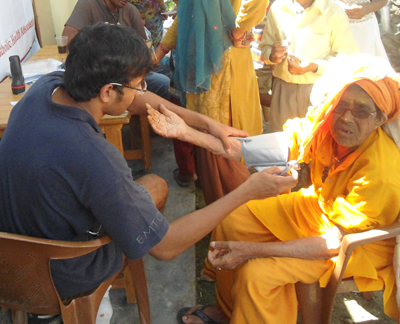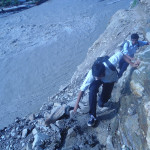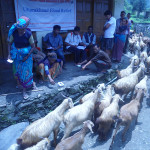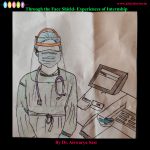In the nascent stages of TREAT, when the team debated on the kind of stories we needed to bring to light for our readers, social impact and change always came to the forefront. Taking a leaf from those early days, we decided that we should bring to light the experience of healthcare teams and specifically doctors who volunteer for medical relief in disaster torn places. Driven by a sense of altruism and adventure, their perspective is unique, sometimes cautionary and always inspiring.
There are many stories of individual heroism and group initiatives when responding to such calls of distress. Close to home, we found our story for the issue- from the St John’s Medical College and Hospital, Bengaluru. Over the last 40 years, starting with the Bangladesh floods and refugee crisis of 1971( ref. from the archives) , this institution has sent groups of doctors in response to natural calamities across India. Over the past two decades, this has become the Disaster Relief Unit which liaises with governmental agencies and NGOs, sending out teams and setting up task forces.
No story is relevant without the voices of the people- we bring you this story from the perspective of two young doctors who were among the first to volunteer for relief work in Uttarakhand.
We use this story to bring to light the needs of the marginalized and while the story highlights a particular group, it is a tribute to all the healthcare professionals who step out of their comfort zones and bring relief to those who otherwise have none. Our title itself is, in a sense a tribute to that guiding light of such organizations, the Medecins sans Frontieres.
IMPRESSIONS
The editorial team at TREAT caught up with two young doctors Murtuza Ghiya and Alex Fonseca soon after their return from Uttarakhand where they had spent two weeks in relief work. They had gone as part of their institution , St John’s Medical College’s response to the relief call from Uttarakhand.
AD: First of all would like to congratulate both of you for the efforts in being part of a disaster relief team during the Uttarakhand floods. It surely must have been an experience. But how did it all start off?
Murtuza: The busy PG life at St. Johns never let us spend time with the newspaper, and even when we managed to find some time, the newspaper would have been flicked by someone from the hostel rec room. So it was not surprising then that the first time we knew about the news of one of the worst floods in India, at Kedarnath, Uttarkhand (U.K.) that happened was when we decided to take the hospital lift and accidently saw the notice board- asking for volunteers to conduct a medical camp there. Before we knew it we were travelling in the Garhwal hills along the banks of the magnanimous and violent river Ganga on our way to represent St. John’s Disaster Management Unit and fight the fury of nature…or so we thought.
AD: What were your first encounters with the healthcare system when you reached your destination?
Alex: We along with a team of nun nurses and a spirited coordinator from Catholic Health Association of India and one animator (guide) conducted medical camps in anganwadis, shops, pachayats, temples and street corners in various villages which were inaccessible due to damaged roads and landslides; treating respiratory infections, gastroenteritis, minor traumas, lots of dermatological issues along with the 2 most common ailments to have eternally plagued all people from all villages- “gas ki takleef” and “ poora body dard”.
AD: The way you put it across seems as if it was like a medical camp conducted in a far of place under normal circumstances. But surely the aftereffects of one of the most devastating floods wouldn’t have made administering treatment easy…..
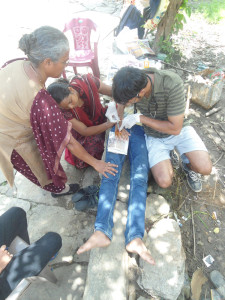 Murtuza: It was travelling to these villages which made our lives not so simple. The journey mainly involved trekking long distances carrying bags and bags of medicine on our backs through dilapidated roads, wild forests, hills, rivulets and artificial tracks through ‘one wrong step and I fall into the river’ type landslides. Occasionally hitching a ride in an overcrowded rickety jeep or on its roof, through slushy, head spinning, gut churning, motion sickness inducing ghats, placing our delicate lives in the nonchalant hands of the driver.
Murtuza: It was travelling to these villages which made our lives not so simple. The journey mainly involved trekking long distances carrying bags and bags of medicine on our backs through dilapidated roads, wild forests, hills, rivulets and artificial tracks through ‘one wrong step and I fall into the river’ type landslides. Occasionally hitching a ride in an overcrowded rickety jeep or on its roof, through slushy, head spinning, gut churning, motion sickness inducing ghats, placing our delicate lives in the nonchalant hands of the driver.
Alex: At the risk of boasting it is pertinent to point out that while 2 other medical teams thought that going further would be nothing less than an attempted suicide, we thought other-wise and reached out to villages which had not received any medical attention even 3 weeks after the floods.
AD: Can you give us an idea on how long was your stay in the disaster hit areas and how many villages you covered?
Murtuza: We covered about 11 villages- from Tilwara-Rampur to Makku . I would say that Total number of patients seen by us to be around 656
AD: Being a doctor in a PHC or even in a city hospital and treating patients is one thing. Being a doctor in a resource poor setting of a disaster hit area is a totally different ball game. What were the kind of medical problems that you encountered
Alex: The medical issues encountered by us could be divided into
a) possibly flood related and needing immediate attention such as fever, acute GE , Respiratory infections, Traumatic injuries, Skin infections, and not to forget anxiety and stress reactions.
b)not flood related but needing immediate attention such as uncontrolled sugars and hypertension of more than 160/100
c) not flood related and not needing immediate attention such as diffuse musculoskeletal pain, gastritis, malnutrition, other chronic ailments
AD: That’s quite a spectrum of conditions. But you would have anticipated the conditions that you would have encountered and prepared accordingly. what were the medicines that you carried with you?
Murtuza: The medicines we carried included antibiotics, anti fungals , analgesics, antipyretics, anti helminths, PPIs, Anti hypertensive and basic surgical kit. We were aware of hoarding that occurs in such situations and hence we did not prescribe more than 2 days’ medications to most patients except those with evident infections.We dispensed i/3 parts of powders and syrups in plastic bottles instead of giving the entire bottle to singular patients.
AD: But even with anticipation and preparations, during such situations, there are bound to be situations that you did not expect or problems that you did not anticipate to occur. Can you share any of those?
Murtuza:We underestimated skin disease medication as a lot more patients had them. We realized that giving clotrimazole powder was cheaper and more cost effective and convenient than the cream. And on the other hand we over estimated acute gastroenteritis and hence many of our free ORS and norfloxacin tablets remained unused. Since most of the patients had chronic aches and pains and gastritis we had to carry adequate analgesics and H 2 blockers ( cheaper than PPIs)
Alex: We ran out of betadine ointment as some pyoderma patients had multiple lesions and needed a lot of solution. Retrospectively, a cheaper and equally effective alternative is gentian violet paint ( if available ) or betadine solution dispensed in plastic cups for daily home dressings. Many patients had stage 2 hypertension and since it’s a daily medication we did not have enough to dispense for adequate periods. Further we noticed a few patients who had early mild cardiac failure and would benefit greatly from a simple tablet like furosemide( lasix), until they are taken to a better medical facility.
AD: What are your general observations or suggestions about the existing health care faciltites in these areas?
Murtuza: Before coming to that, a point I would like to make is that most of the easily accessible villages had been covered by a medical team ; infact there was a significant overlap between teams in these areas.The more difficultly accessible areas had been neglected– Eg- Jagpura, Makku, Parkhandi, Uthindi etc
Alex: Infact we have written a letter to the Chief Minister giving our observations and suggestions. We feel that the need of doctors would be more from the field of community medicine, general medicine, and possibly pediatrics. A brief 5-7 day training in basic dermatological infectious diseases organized by their respective hospitals, prior to their Uttarkhand posting, would further augment their quality of medical care.
Murtuza: We learnt that many of the CHCs and PHCs, especially in remote villages did not have duty doctors. We are told this has been a longstanding problem as it was difficult to post doctors here since no doctors were willing to work here due to personal issues like family/spouse, safety, poor facilities and infrequent leave to visit home. A solution could be in the form Posting interns here, who anyway have a 2 month community medicine posting in a rural area as a part of their training before they can acquire a degree along with a Community health post graduates, who also have a 6 month rural posting.
AD: I am sure that overall it would definitely have been a holistic and an incredible experience to serve in a disaster hit area . Now that you have come back and have had some time to reflect on the whole experience can you sum it up for the readers??
Murtuza & Alex: We were in the midst of a way of life in the hills very different from the routine life as a post-graduate resident in a tertiary care setup. Planning, conceiving and organizing medical camps by interacting with locals, other NGO’s, MSW students, journalists, District magistrates; tested our abilities every day. With a few bruises, leech infested feet, and the Uttarakhand URTI , we became stronger if not wiser. Overall it was a very enriching experience witnessing nature’s fury and man’s zeal and resilient fighting spirit to rebuild. Even if the show doesn’t go on….life certainly will go on.
FROM THE ARCHIVES/ SEPIA

